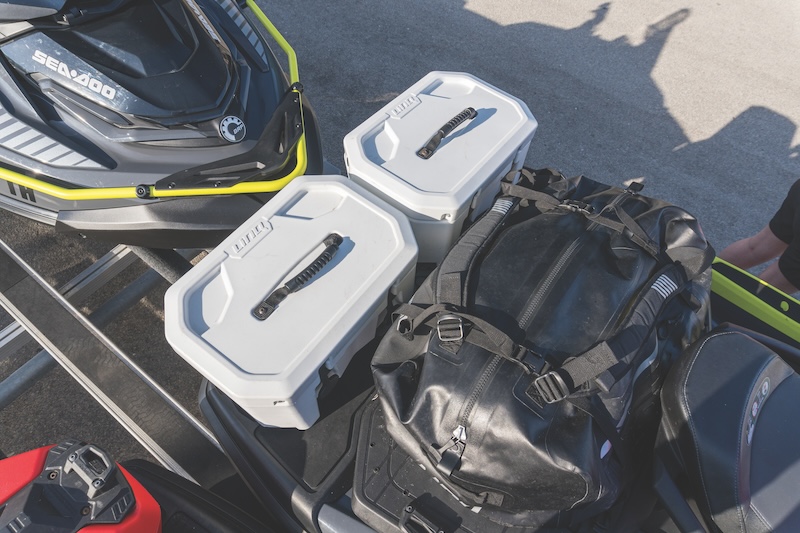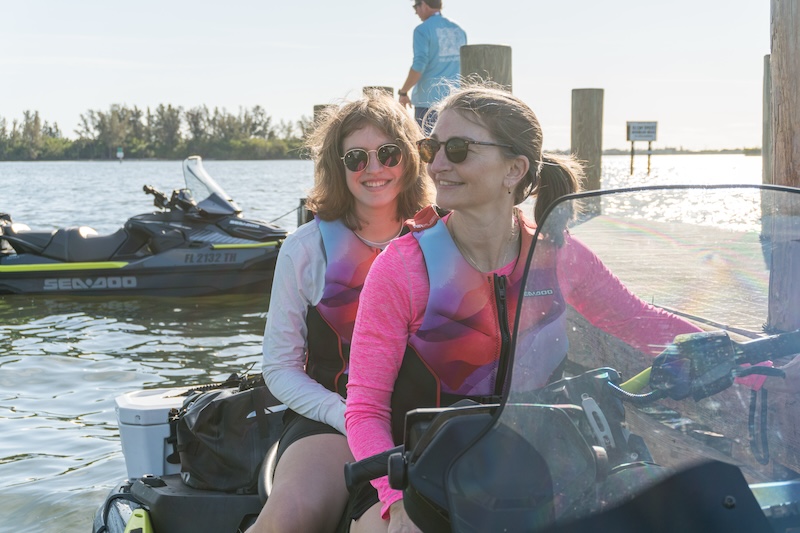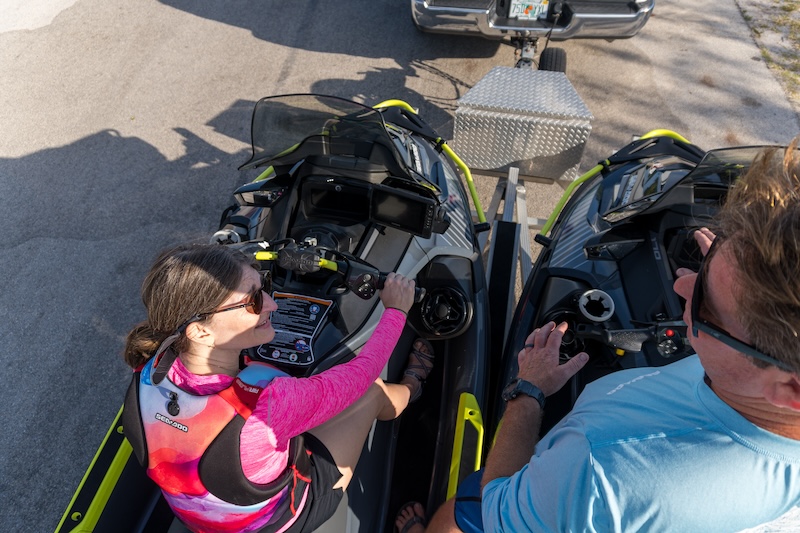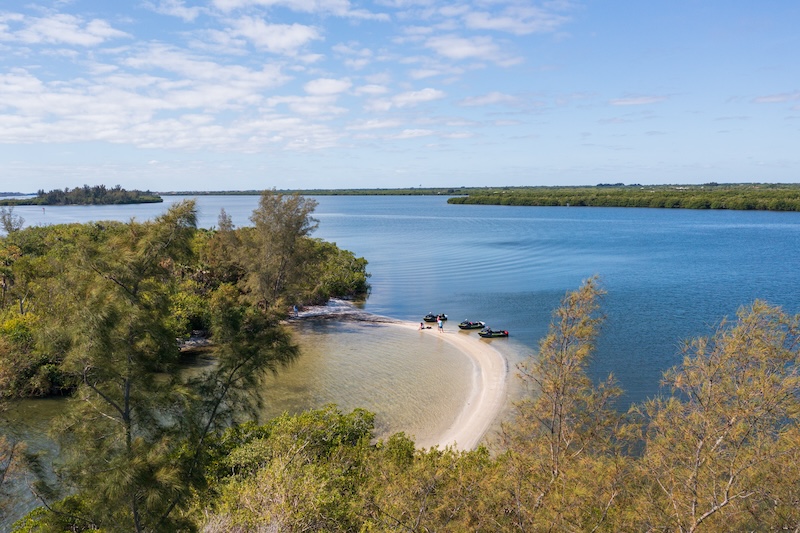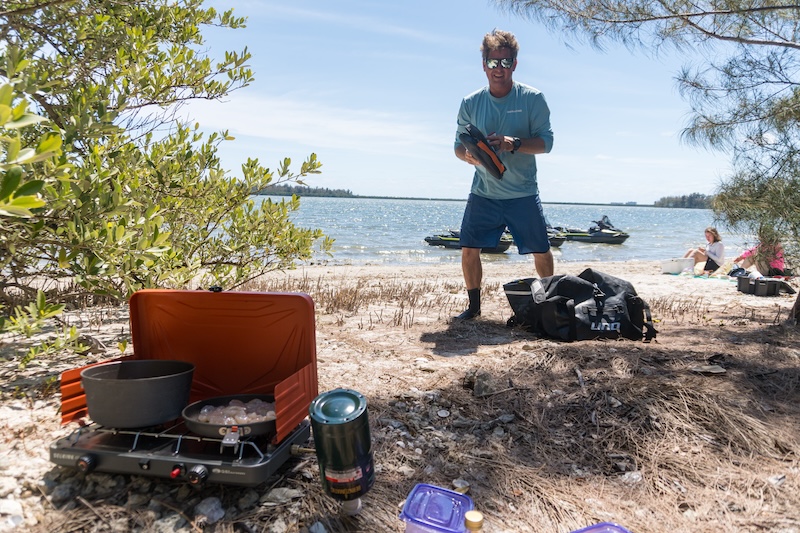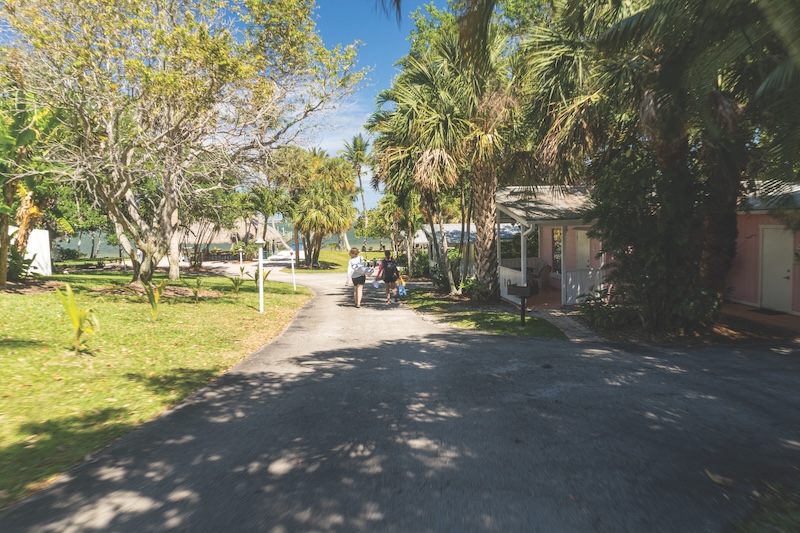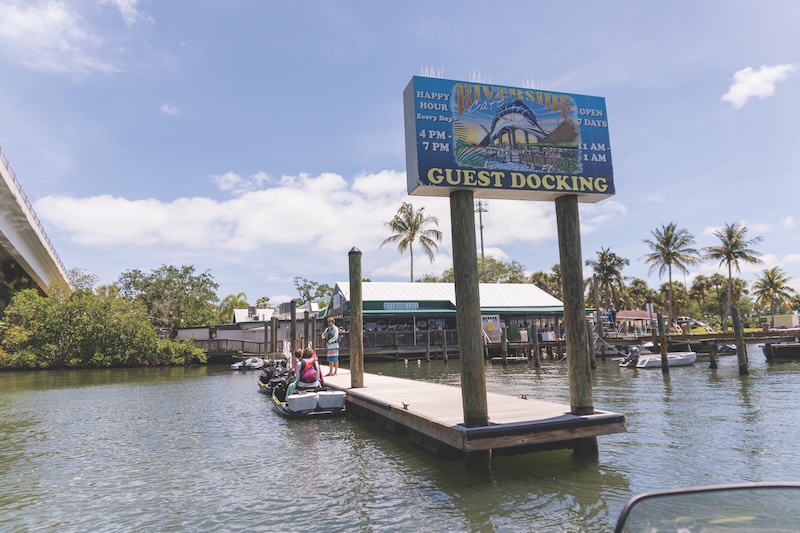
A 120-mile family adventure on Florida’s Indian River aboard personal watercraft.
The whitecaps are coming fast and furious, driven hard by a piping east-southeast wind and the near-constant wakes of large cruising boats heading north. My hands ache as I ease up on the throttle, gun it again, and maneuver over yet another wave that seems to strike from an odd direction.
My Sea-Doo suddenly collides with the wave behind it, launching a cascade of saltwater into the air. We are instantly soaked.
“Sorry!” I shout over my shoulder to my daughter, Johanna. “Are you oka…” Before I can finish, I get another faceful of water.
Mike Longman, our tour guide, stops, and my husband, Richard, and I slowly pull up alongside him. Richard looks as bedraggled as I feel, but he flashes an encouraging smile.
“See that bridge?” Mike says, pointing south. “We need to go just past that, and then to the right.”
The faint span of Jensen Beach’s Frank A. Wacha Bridge sits low in the distance. Ahead of us lay a seething, wide-open stretch of water that makes me think of what a bathtub might look like if it were filled with egg beaters.
“Are you ready?” Mike asks.
We nod. He roars ahead, leaving a frothy wake across the tattered surface. Richard follows, rocketing past the wake to carve his own path.
“Hang on,” I call to Johanna. “Here we go!”
An unusual adventure
Like countless other American families, we chose Florida for our daughter’s spring break this year. Instead of planning a trip to the Orlando theme parks, however, we opt for something a bit more unusual: A two-day, 120-mile voyage on the Indian River Lagoon aboard Sea-Doo Explorer Pro personal watercraft.
Over our 20-plus years together, Richard and I have relished every possible opportunity to enjoy multi-day adventures with backpacks, sea kayaks, rafts or bicycles. We were excited to experience something new. Our 15-year-old daughter wasn’t so sure.
“So, I’m just going to sit on this thing all day?” she asks. “On a boat, at least I can listen to music or draw. What if I get bored?”
“Trust me,” I say. “You’re going to love this.”
She looks unconvinced.
Just after dawn on departure day, we arrive in Melbourne, Florida, to find three Sea-Doo Explorer Pros on their quad trailer, fueled and ready to go. We just have to load our gear, and then we can head for the boat ramp.
I was impressed by the sheer size of the Explorer Pro. Not only does it incorporate an ST3 deep-V hull, but it also features an 11.5-inch rear deck extension with a LinQ Multi Cargo Rack.
For those not in the know, LinQ is a plug-and-play system that allows you to easily attach and swap out add-ons such as coolers, dry bags, fuel caddies and storage bins. Mike attaches coolers to our unit and his own, while Richard uses that extra space for his massive Pelican case filled with photo gear.
Even with coolers and cases, we still have room on our units to attach the large LinQ dry bags that would hold our overnight belongings. Although we have more room in our bag, I thought it might be wise to distribute some weight forward, so we place Johanna’s personal (and overstuffed) dry bag in the enormous direct-access storage in the helm console.
We still have space for my purse, our snacks, a tote filled with hats and sunscreen, and two neoprene rider jackets. I cannot imagine needing these jackets on such a warm day, so they go on the bottom.
Closing the console, I take in the angled windshield, Garmin 7-inch touchscreen GPS, deep footwells, Explorer Touring seat, wrap-around grabrail at the bow and cleverly stowed gear at the stern. Everything about the Explorer Pro screams long-distance riding.
“You sit in it more than on it,” Mike observes. “It has a low center of gravity and it’s super stable.
“BRP realized that people were kitting out their units for long-distance adventures anyway,” he adds. “The demand was there, and they want people to operate their machines safely, so they designed the Explorer Pro.”
Spoil island just off Barker Island at Indian River Shores
Mike makes beach tacos at Spoil Island IR43
Beach tacos at Spoil Island IR43, looking toward Round Island and Avalon state parks
Entering another world
We drive 12 miles south to Grant-Valkaria and launch the machines at Christenson’s Landing, right on the Intracoastal Waterway. Here, the ICW threads its way through the 121-mile Indian River, a brackish Atlantic estuary dotted with sandy spoil islands.
When we reach the ICW’s main channel, we shift from the standard touring mode to Eco mode. This allows us to conserve fuel on the roughly 60-mile run down to Jensen Beach.
“In Eco mode, you should be able to go about 130 miles on a tank,” Mike tells us. “We have plenty of fuel, so if we hit some nice flat stretches, feel free to try Sport mode!”
By 9 a.m., we are cruising southward at a comfortable 20 – 25 mph. The morning chill is long gone, and I feel comfortable in my sun shirt and shorts. I also enjoy the increasingly enthusiastic narration behind me.
My teenager is fully absorbed in what’s happening around her. She spots an osprey feeding her chicks in a nest atop a channel marker, the flash of a dolphin’s distinctive dorsal fin, and a squadron of pelicans crashing face-first into what is, presumably, a school of fish.
She marvels at the decked-out cruising boats heading north for the summer, asks about the Great Loop, learns the difference between catamarans and trimarans, and watches a mobile boat hoist at work. She is also the first to spot the turquoise infusing the lagoon’s dark water as we near Sebastian Inlet.
I marvel at the fact her phone is not the first thing in her hand when we stop at a forested spoil island adjacent to Barker Island. Instead, when we beach the Explorer Pros, she grabs a snack and splashes into the translucent shallows.
“Mom! Look at all the little fish!” she says.
I look and nod, then stroll along a narrow, crescent-shaped strip of golden sand to a smaller islet. These islands emerged from the dredging of the ICW in 1951-61, and I’m amazed to see how the literal spoils of such an operation could become such an ecologically rich playground for boating, fishing, bird- and wildlife-watching, picnicking and camping.
“Growing up, we were always out here in the islands,” Mike says. “It feels like you’re a million miles from anywhere.”
About 14 miles south, we beach the Explorer Pros again for a picnic lunch — this time at the colorfully named Spoil Island IR43. Mike unloads his camp stove, propane fuel and kitchen supplies, and we help unclip coolers and carry them ashore.
The wind had steadily increased throughout the morning, so Mike sets up his camp kitchen on a protected knoll in the trees. Soon, seasoned shrimp and chicken sizzle on the little dual-burner propane stove.
Mike thought of everything, including fresh lettuce, onions, tomatoes, avocado and salsa. Our beach tacos taste even better than we expect with a generous dose of sun, sea and sand.
Ready, set, drive
We reload the Explorer Pros, push back, and start the engines as soon as we are in deep water. I quickly realize something is amiss.
My Explorer Pro is cranky, lurching unpleasantly with every turn of the handlebars. When Mike looks back to check on me, I wave him over.
“What’s wrong?” he asks.
“It feels really unbalanced,” I tell him.
Turns out, when we left the beach, we put one cooler and a lighter storage box on my aft deck instead of two coolers. That made my machine significantly lighter on one side.
While I hold onto Mike’s grabrail, he moves the storage box to his platform and returns the second cooler to me. Within minutes, we’re on our way again.
The machine feels perfectly stable. I do have to trim the bow slightly, but that’s to be expected.
“It’s usually not necessary,” Mike says, “but with all the gear and an extra rider, you have the most sensitive driving and handling situation.”
He looks apologetic, but I just smile, remembering what it feels like to pedal a fully loaded bicycle through the sand at Cumberland Island and to carry a 35-pound backpack through the Great Smoky Mountains. If it were always easy, it wouldn’t be an adventure.
Cruising past Fort Pierce Inlet and through the no-wake zone near the Manatee Education and Observation Center, we are somewhat protected from the sustained 20-mph wind; I even adjust the handlebars so I can stand for a while. As soon as the lagoon widens, however, the wind hits us right on the nose.
The seas respond accordingly. I tuck behind the windshield, brace my feet and legs against the footrests and kneepads, and narrow my focus to the next wave.
And the next. And the next.
This is new to me, and I’m unsure about the ideal speed for these conditions. Unfortunately, going too slowly means slogging through the waves and getting drenched.
After my third or fourth soaking, I hear a giggle. Clearly, I’m serving as a human breakwater.
Then I start to laugh. I throttle up and charge ahead, steering this way and that, experimenting as I attempt to keep the ride as dry as possible. With every fresh deluge, we laugh harder, and when we catch some air, we make a loud “whoop!” This isn’t just riding — this is driving.
A break at Spoil Island SL17
Adventures rewards
Relief and joy course through me in equal measure when we spot the River Palm Cottages & Fish Camp dock around 3 p.m. We made it.
The little old-school resort is a haven with inviting cottages and motel buildings, shady lanes and lush grounds sprinkled with flowers. We unload the Explorer Pros on the beach, and Mike secures them to the dock for the night.
The highlight of our evening is a three-way tie between the long, hot shower; the delectable seafood at the waterfront Dolphin Bar & Shrimp House, a 1-mile walk down the road; and collapsing into a soft bed for a deep, dreamless sleep. We savor all three.
Over coffee the next morning, when it becomes clear the wind hasn’t settled down overnight, we make a couple of adjustments to our return trip. First, we pull out the rider jackets because we are clearly going to get wet.
Next, Mike plots a course across the lagoon. Snugged against the barrier islands’ west coast, we can make our way north until the channel narrows, and then we will be in more protected water.
Indeed, the boisterous conditions ease as soon as we fall into the lee of the islands. Even better, the wind is now behind us, giving us a friendlier following sea.
Feeling more confident, I hold our cruising speed at 25 mph, and in a few stretches, we even hit 30. Every so often, we catch a wave just right and surf.
It’s a beautiful day, and I can’t stop smiling. Neither can Johanna when she realizes she is the only one to see a manatee’s cautious snout emerge just outside the channel.
Near Fort Pierce Inlet, we stop at Spoil Island SL17 for a quick snack. Just 17 miles farther north, hungry again, we pull into the guest dock at the Riverside Cafe in Vero Beach.
We take our time over our burgers and fries, tossing pellet food to the countless catfish and one massive snook trolling for treats below the wooden deck. And we stall a little walking back to the dock. The adventure is almost over.
Christenson’s Landing appears off our port rail at 2 p.m., and we each drive our own machine onto the quad trailer. Johanna and I sit on ours as we wait for Mike to haul us out.
“Well?” I ask. “Was it OK after all?
She nods and gives me a broad grin.
“Hey, Mom, you got it on the trailer on the first try. That’s so awesome.” As I bask in the glow of this unexpected praise, she adds, “What about you? Did you have a good time?”
Words suddenly fail me. I can’t find the right ones to express the magic of exploring the Indian River and its otherworldly spoil islands; the thrill of learning to handle a variety of conditions over 120 miles and 12 driving hours; and the sheer pleasure of discovering new destinations by water.
I also can’t express what it means to share this real adventure with my family, fully unplugged. All I can do is catch my girl in a bear hug and tell her softly, “Yes, sweetheart. I really did.”
River Palm Cottages & Fish Camp in Jensen Beach
River Palm Cottages & Fish Camp in Jensen Beach
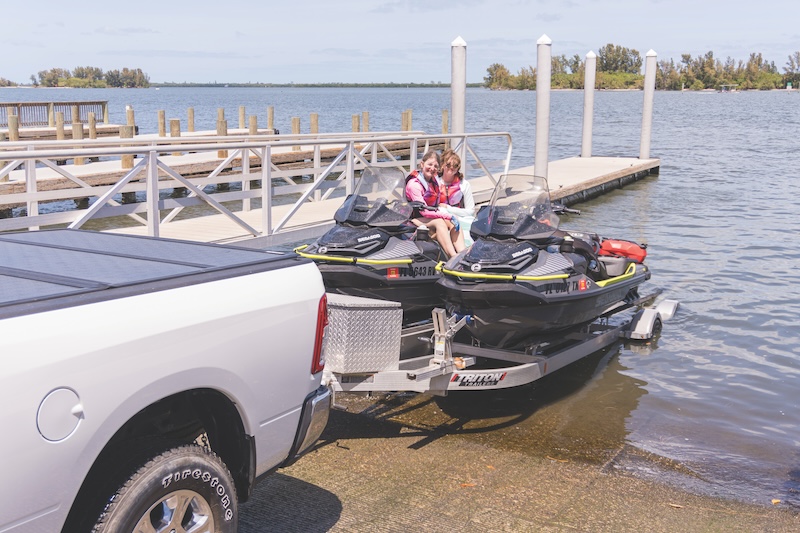
The adventure ends at Christenson’s Landing
10 PWC Adventure Tips
- Bring neoprene ride jackets, even if you think you won’t need them.
- When you load your gear, be intentional about balancing weight. It makes a big difference when you’re packed for a long-haul adventure.
- Bring plenty of water, electrolyte-replacement drinks and snacks. A 150-pound person will burn roughly 200 – 250 calories per half hour when actively riding.
- If you’re not familiar with your cruising route and no one else in your party has local knowledge, study the charts ahead of time. In some areas, no- and low-wake zones might not be clearly marked, or existing signage might be confusing.
- Know the rules of the road. Just as you wouldn’t do donuts on a busy highway, don’t play around in the main channel. The lack of lane lines on the water doesn’t mean “anything goes.”
- Remember: Safety first. Wait to turn on your PWC until you’ve put on your life jacket and attached the engine cut- off switch.
- Switch to Eco mode to conserve fuel and maximize range (and bring extra fuel, just in case).
- Use sunscreen, and reapply when you stop for food or
to stretch your legs. Consider wearing ride gloves, a lightweight UV-protection shirt, and a buff that will cover your neck and face, as well. - At rest stops, practice Leave No Trace ethics. Pack your trash out and, yes, that includes toilet paper.
- Keep an eye out for sandbars and snags. Conditions are constantly changing in marine environments, and not all obstacles will appear on the charts.


